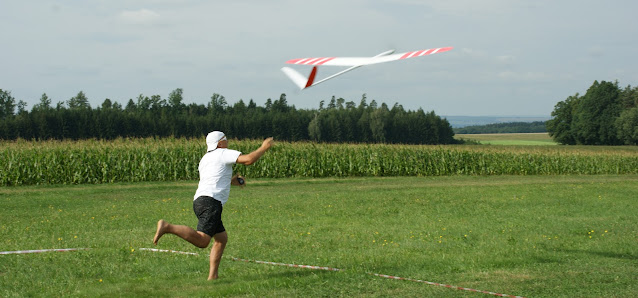Four rounds were flown, all of which were counted. Based on the results, one could speak of an Austrian championship, ...haha! In the F3G class, Wolfgang Hirth (AUT) came out ahead of Helmut Gronau (AUT) and Günther Aichholzer (AUT). In the F3B class, Bernhard Flixeder (AUT) won, ahead of Hans Rossmann (AUT) and Gerhard Flixeder (AUT).
The best German was Thomas Gruber in 5th place (average time 14.58s), followed by Hans-Peter Haase in 6th place (average time 14.65s) and Tim Bischoff in 7th place. Tim flew with his new Quantum 2 DP and achieved an average time of 14.76s. Robert Karow made it to 20th place. It was his first F3G competition with his Quantum 2 DP. His time averaged 16.17s.
Congratulations again to all pilots for the impressive and consistent performance. The start was a real celebration of fast times.
The F3G and F3B World Cup followed from May 11th to May 12th with its familiar tasks of time flight, cross-country flight and speed flight. People also like to talk about Formula 1 in model gliding!
The Kulmbach Model Aviation Association has implemented some good ideas so that the tight schedule does not have to be interrupted too often. This means that 14 landing points were used in the time flight. 7 landing points for F3B and 7 landing points for F3G. The run was perfect. As soon as a group from class F3B had completed their task, a group from class F3G followed. The pilots were able to help each other and were checked by official referees.
Switching between classes has not proven successful in cross-country flights. All F3B pilots first flew here and then all F3G pilots. This meant that the pilots of the resting class were able to assist as helpers during the A or B turn. Full attention must be given in all tasks, whether as a pilot, helper or marshal. The mutual support ensured a lot of joy and respect among all the helping hands. The experienced pilots, who know the terrain in Kulmbach, have already rubbed their hands in advance! After the first round we knew why! Despite the very good weather conditions, the area has one or two surprises in store. In one round there were 15 routes for 1000 points and in the next round there were 30 routes for 1000 points. At no point was there a guarantee of a successful passage.
The procedure for the speed flight followed that of the cross-country flight. One class flies and the helping hands of the resting class were again welcome guests at the turning points.
Here too you could see the weather conditions based on the starting altitudes. The F3B class was between 230m and 300m and the F3G class was between 300m and 370m.
The starting heights of class F3G are repeatedly criticized and classified as significantly too high. We should all not forget that this is an emerging FAI class. The development steps will come, but little by little. The F3G and F3B classes fly almost the same tasks. However, we must not forget that F3G is a separate class and still has some development steps ahead of it. We have to give it time and believe me, F3G pilots all over the world are enjoying the benefits and the different flying experience!
We took a very special path with the competition in Kulmbach and I would like to thank the Kulmbach model flight association on behalf of all F3G and F3B pilots. This combined season opening is something very special and has potential for the successful continuation of our competitive sport.
We are looking forward to the next stop in Colmar (FRA). The next World Cup and Eurotour competition in class F3G will take place here at the beginning of June. Further information can be found at www.f3g.info
The F3B pilots are already on their way to Örebro (SWE) before stopping off in Nardt (GER) in June 2024. www.f3b.de
Until then, we wish all pilots good flights and great experiences.
We congratulate the first place winners in class F3G
- Petr Fusek (CZ)
- Hans Rossmann (AUT)
- Wolfgang Hirth (AUT)
The best German was Sebastian Haase in 7th place, followed by Thomas Gruber in 8th place and Stefan Eder in 12th place
We congratulate the first place winners in class F3B
- Steffen Besemer (GER)
- Bernhard Flixeder (AUT)
- Jens Buchert (GER)
You can find further results at www.mg-airsports.eu


































































